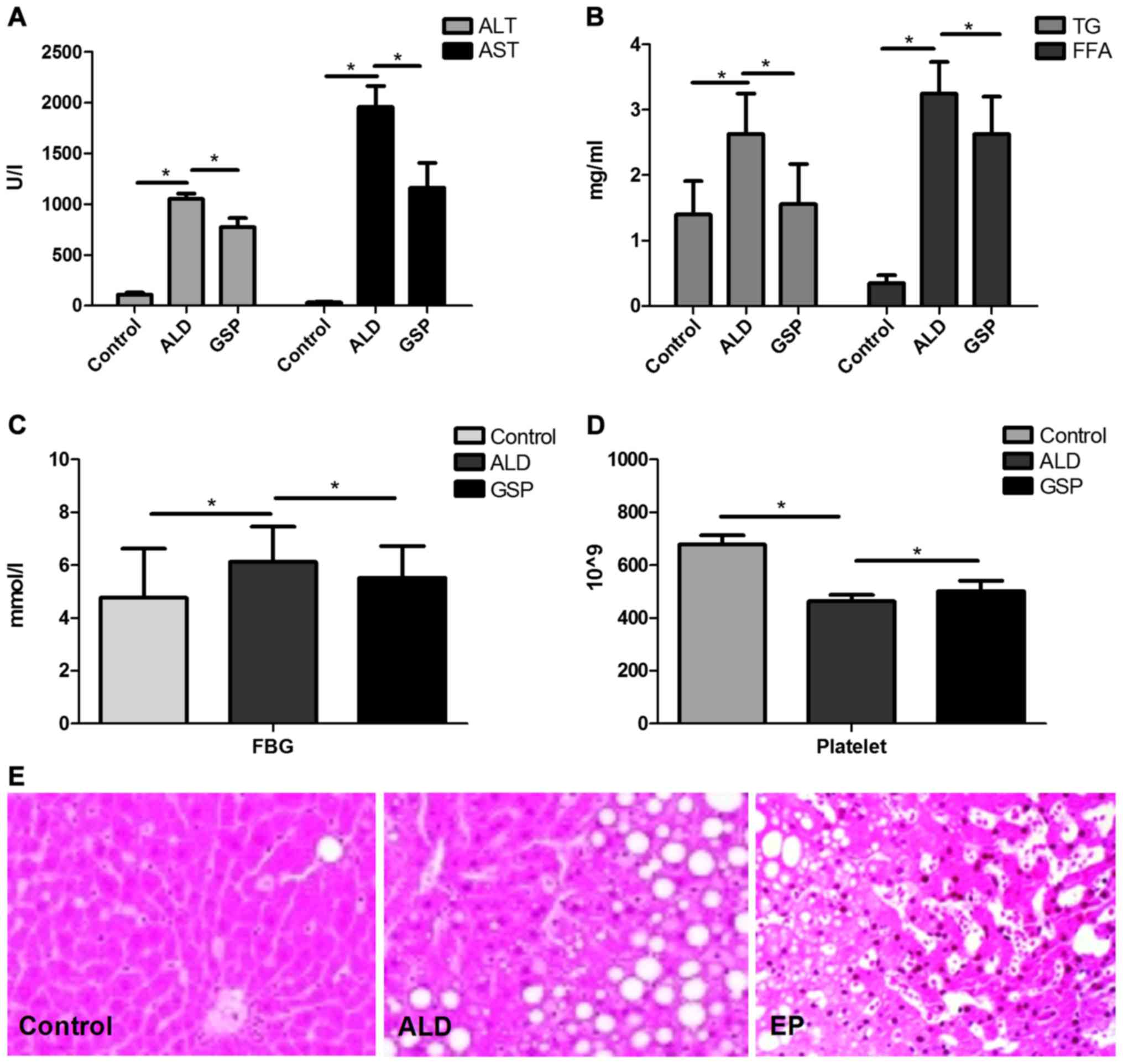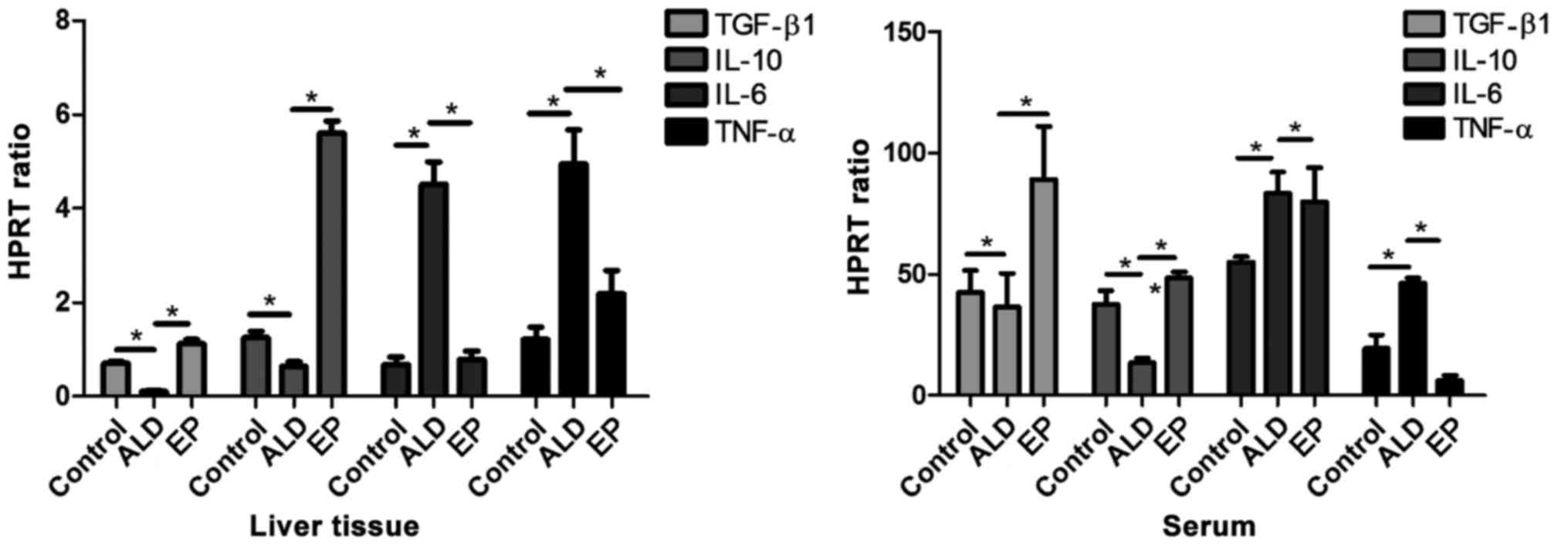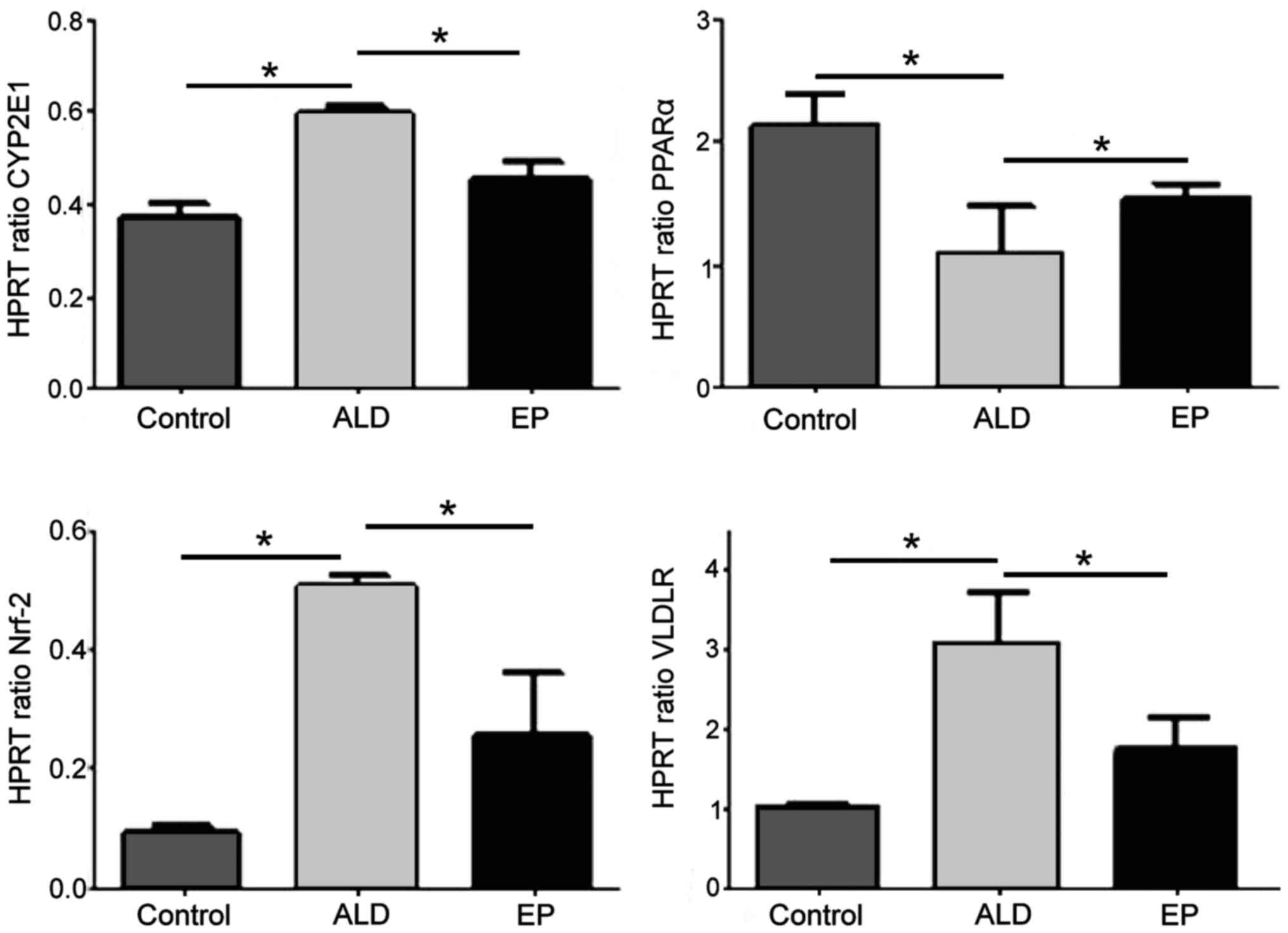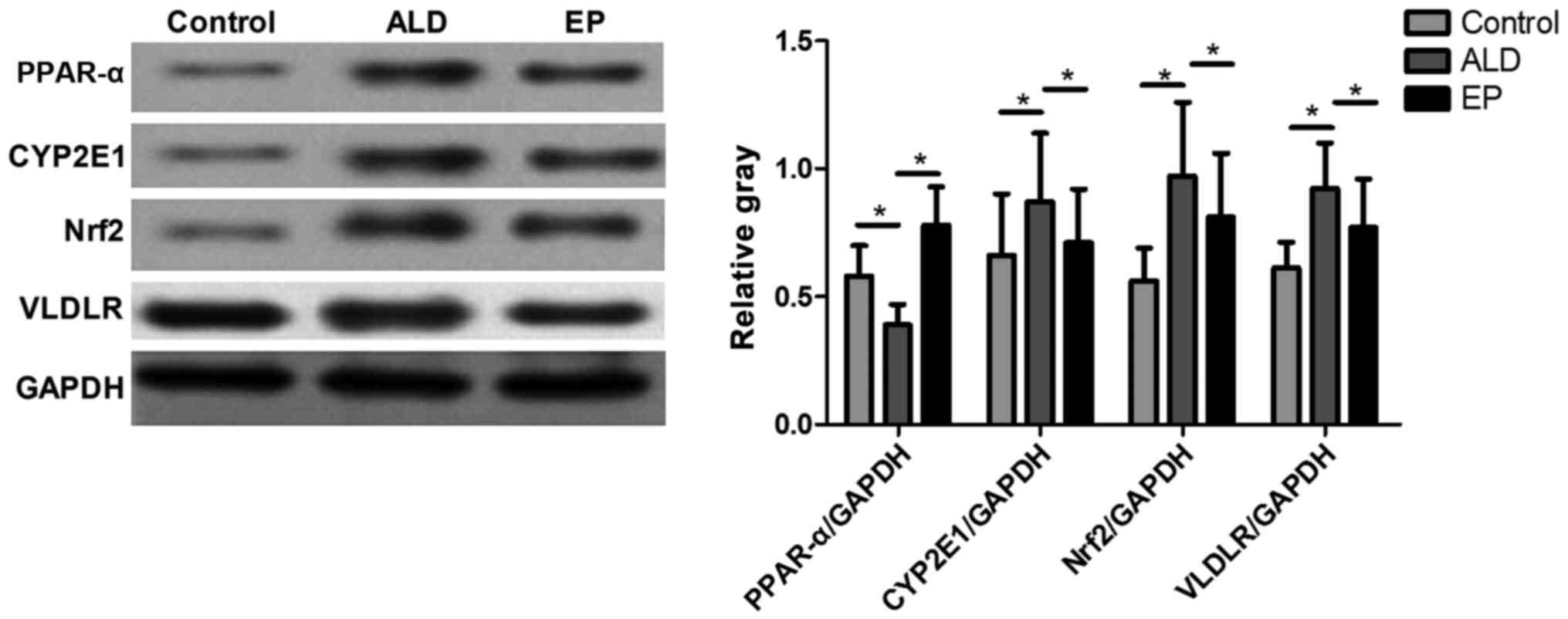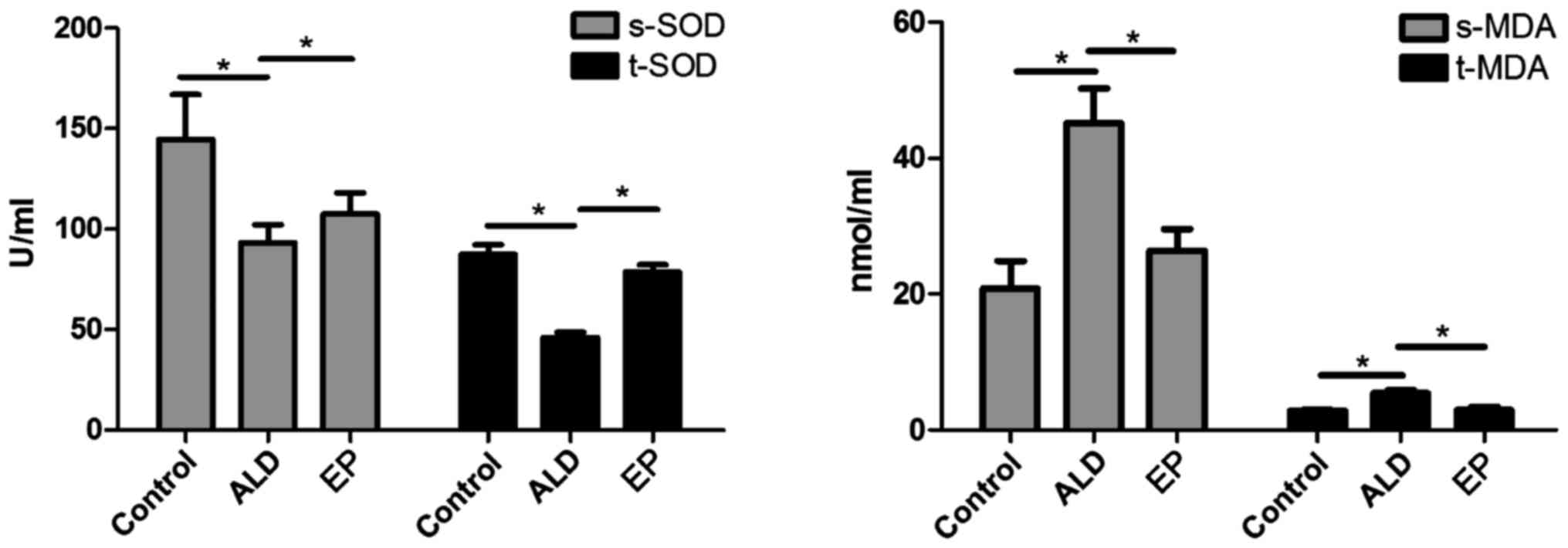|
1
|
Yin HQ, Choi YJ, Kim YC, Sohn DH, Ryu SY
and Lee BH: Salvia miltiorrhiza Bunge and its active
component cryptotanshinone protects primary cultured rat
hepatocytes from acute ethanol-induced cytotoxicity and fatty
infiltration. Food Chem Toxicol. 47:98–103. 2009. View Article : Google Scholar : PubMed/NCBI
|
|
2
|
Cioboată R, Găman A, Traşcă D, Ungureanu
A, Docea AO, Tomescu P, Gherghina F, Arsene AL, Badiu C, Tsatsakis
AM, et al: Pharmacological management of non-alcoholic fatty liver
disease: Atorvastatin versus pentoxifylline. Exp Ther Med.
13:2375–2381. 2017. View Article : Google Scholar : PubMed/NCBI
|
|
3
|
Tilg H, Moschen AR and Kaneider NC:
Pathways of liver injury in alcoholic liver disease. J Hepatol.
55:1159–1161. 2011. View Article : Google Scholar : PubMed/NCBI
|
|
4
|
Zhong W, Zhao Y, Tang Y, Wei X, Shi X, Sun
W, Sun X, Yin X, Sun X, Kim S, et al: Chronic alcohol exposure
stimulates adipose tissue lipolysis in mice: Role of reverse
triglyceride transport in the pathogenesis of alcoholic steatosis.
Am J Pathol. 180:998–1007. 2012. View Article : Google Scholar : PubMed/NCBI
|
|
5
|
Gurel H, Genc H, Celebi G, Sertoglu E,
Cicek AF, Kayadibi H, Ercin CN and Dogru T: Plasma pentraxin-3 is
associated with endothelial dysfunction in non-alcoholic fatty
liver disease. Eur Rev Med Pharmacol Sci. 20:4305–4312.
2016.PubMed/NCBI
|
|
6
|
Wang Z, Dou X, Li S, Zhang X, Sun X, Zhou
Z and Song Z: Nuclear factor (erythroid-derived 2)-like 2
activation-induced hepatic very-low-density lipoprotein receptor
overexpression in response to oxidative stress contributes to
alcoholic liver disease in mice. Hepatology. 59:1381–1392. 2014.
View Article : Google Scholar : PubMed/NCBI
|
|
7
|
Jo H, Choe SS, Shin KC, Jang H, Lee JH,
Seong JK, Back SH and Kim JB: Endoplasmic reticulum stress induces
hepatic steatosis via increased expression of the hepatic very
low-density lipoprotein receptor. Hepatology. 57:1366–1377. 2013.
View Article : Google Scholar : PubMed/NCBI
|
|
8
|
Fawcett TW, Martindale JL, Guyton KZ, Hai
T and Holbrook NJ: Complexes containing activating transcription
factor (ATF)/cAMP-responsive-element-binding protein (CREB)
interact with the CCAAT/enhancer-binding protein (C/EBP)-ATF
composite site to regulate Gadd153 expression during the stress
response. Biochem J. 339:135–141. 1999. View Article : Google Scholar : PubMed/NCBI
|
|
9
|
Harding HP, Zhang Y, Bertolotti A, Zeng H
and Ron D: Perk is essential for translational regulation and cell
survival during the unfolded protein response. Mol Cell. 5:897–904.
2000. View Article : Google Scholar : PubMed/NCBI
|
|
10
|
Lieber CS and DeCarli LM: Effects of
mineral and vitamin supplementation on the alcohol-induced fatty
liver and microsomal induction. Alcohol Clin Exp Res. 13:142–143.
1989. View Article : Google Scholar : PubMed/NCBI
|
|
11
|
Wang X and Cederbaum AI: Acute ethanol
pretreatment increases FAS-mediated liver injury in mice: Role of
oxidative stress and CYP2E1-dependent and -independent pathways.
Free Radic Biol Med. 42:971–984. 2007. View Article : Google Scholar : PubMed/NCBI
|
|
12
|
Kozutsumi Y, Segal M, Normington K,
Gething MJ and Sambrook J: The presence of malfolded proteins in
the endoplasmic reticulum signals the induction of
glucose-regulated proteins. Nature. 332:462–464. 1988. View Article : Google Scholar : PubMed/NCBI
|
|
13
|
Zhang X, Wang Z, Li J, Gu D, Li S, Shen C
and Song Z: Increased 4-hydroxynonenal formation contributes to
obesity-related lipolytic activation in adipocytes. PLoS One.
8:e706632013. View Article : Google Scholar : PubMed/NCBI
|
|
14
|
Tsung A, Kaizu T, Nakao A, Shao L, Bucher
B, Fink MP, Murase N and Geller DA: Ethyl pyruvate ameliorates
liver ischemia-reperfusion injury by decreasing hepatic necrosis
and apoptosis. Transplantation. 79:196–204. 2005. View Article : Google Scholar : PubMed/NCBI
|
|
15
|
Cabezas Castro M, Erkelens DW and van Dijk
H: Free fatty acids: Mediators of insulin resistance and
atherosclerosis. Ned Tijdschr Geneeskd. 146:103–109. 2002.(In
Dutch). PubMed/NCBI
|
|
16
|
Yellen P and Foster DA: Inhibition of
fatty acid synthase induces pro-survival Akt and ERK signaling in
K-Ras-driven cancer cells. Cancer Lett. 353:258–263. 2014.
View Article : Google Scholar : PubMed/NCBI
|
|
17
|
Boden G, She P, Mozzoli M, Cheung P,
Gumireddy K, Reddy P, Xiang X, Luo Z and Ruderman N: Free fatty
acids produce insulin resistance and activate the proinflammatory
nuclear factor-kappaB pathway in rat liver. Diabetes. 54:3458–3465.
2005. View Article : Google Scholar : PubMed/NCBI
|
|
18
|
Chang BH, Li L, Paul A, Taniguchi S,
Nannegari V, Heird WC and Chan L: Protection against fatty liver
but normal adipogenesis in mice lacking adipose
differentiation-related protein. Mol Cell Biol. 26:1063–1076. 2006.
View Article : Google Scholar : PubMed/NCBI
|
|
19
|
Samarghandian S, Azimi-Nezhad M, Borji A,
Samini M and Farkhondeh T: Protective effects of carnosol against
oxidative stress induced brain damage by chronic stress in rats.
BMC Complement Altern Med. 17:2492017. View Article : Google Scholar : PubMed/NCBI
|
|
20
|
Collins AR: Oxidative DNA damage,
antioxidants, and cancer. BioEssays. 21:238–246. 1999. View Article : Google Scholar : PubMed/NCBI
|
|
21
|
Xiong Y, Ye T, Wang M, Xia Y, Wang N, Song
X, Wang F, Liu L, Zhu Y, Yang F, et al: A novel cinnamide YLT26
induces breast cancer cells apoptosis via ROS-mitochondrial
apoptotic pathway in vitro and inhibits lung metastasis in vivo.
Cell Physiol Biochem. 34:1863–1876. 2014. View Article : Google Scholar : PubMed/NCBI
|
|
22
|
Yang R, Han X, Delude RL and Fink MP:
Ethyl pyruvate ameliorates acute alcohol-induced liver injury and
inflammation in mice. J Lab Clin Med. 142:322–331. 2003. View Article : Google Scholar : PubMed/NCBI
|
|
23
|
Naour S, Espinoza BM, Aedo JE, Zuloaga R,
Maldonado J, Bastias-Molina M, Silva H, Meneses C,
Gallardo-Escarate C, Molina A, et al: Transcriptomic analysis of
the hepatic response to stress in the red cusk-eel (Genypterus
chilensis): Insights into lipid metabolism, oxidative stress
and liver steatosis. PLoS One. 12:e01764472017. View Article : Google Scholar : PubMed/NCBI
|
|
24
|
Ramadori P, Drescher H, Erschfeld S,
Schumacher F, Berger C, Fragoulis A, Schenkel J, Kensler TW, Wruck
CJ, Trautwein C, et al: Hepatocyte-specific Keap1 deletion reduces
liver steatosis but not inflammation during non-alcoholic
steatohepatitis development. Free Radic Biol Med. 91:114–126. 2016.
View Article : Google Scholar : PubMed/NCBI
|
|
25
|
Sun X, Yamasaki M, Katsube T and Shiwaku
K: Effects of quercetin derivatives from mulberry leaves: Improved
gene expression related hepatic lipid and glucose metabolism in
short-term high-fat fed mice. Nutr Res Pract. 9:137–143. 2015.
View Article : Google Scholar : PubMed/NCBI
|
|
26
|
Hamed AM, El-Kharashi OA, Boctor SS and
Abd-Elaziz LF: Potential involvement of PPAR α activation in
diminishing the hepatoprotective effect of fenofibrate in NAFLD:
Accuracy of non-invasive panel in determining the stage of liver
fibrosis in rats. Biomed Pharmacother. 85:68–78. 2017. View Article : Google Scholar : PubMed/NCBI
|
|
27
|
Qiu P, Dong Y, Li B, Kang XJ, Gu C, Zhu T,
Luo YY, Pang MX, Du WF and Ge WH: Dihydromyricetin modulates p62
and autophagy crosstalk with the Keap-1/Nrf2 pathway to alleviate
ethanol-induced hepatic injury. Toxicol Lett. 274:31–41. 2017.
View Article : Google Scholar : PubMed/NCBI
|















